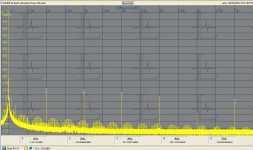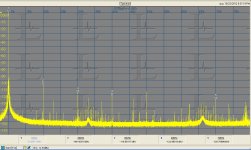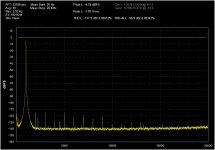I still think Victor's oscillators are the best deal. Contact him here: viccc at ml dot lv Anything else will be a lot of work and probably not as good.
doh! I thought the brand was Chinese
How much output? Can or cannot produce a 2,83V signal?A QA400 will do a fine job of analyzing and is a real value for the price. However its limited to 1V in and not much more out. I'm working on an interface to make it more useful but got sidetracked by real work.
I don't remember anything wrt this in their specs...
Last edited by a moderator:
Hyper-Tuned
Hi Demian --- Do you have a schematic for the AG16 that I could look at?
Working on the FFT part.... Thx-Richard
That is exceptional. Looks like you won't need my AG16 for long.
If you have a spectrum analyzer you can connect it to the distortion monitor and see all the harmonics. It doesn't need much dynamic range or frequency range either.
Hi Demian --- Do you have a schematic for the AG16 that I could look at?
Working on the FFT part.... Thx-Richard
Last edited:
Not RMS -- 1VRMS is essentially full output for QA400.
Looks like I have to look elsewhere, thanks. I need to test power amps with standard input signal (2V or 2.83V).
I followed the thread a bit at the beginning, then got lost and i'm following again... Richard, do you plan to use the spectrum analyzing function of the 339A somehow?
Otherwise my best bet is to go for the 239A and do the mods there, is smaller and cheaper (I have limited bench space). Or should I shell the money for a Krohn-Hite 4400A?
My goals are sub-ppm @50hz, 1khz and 20khz.
I painstakingly worked adjusting my KH4402:
I've posted it once before, but misplaced the jpeg.
An externally hosted image should be here but it was not working when we last tested it.
I've posted it once before, but misplaced the jpeg.
HP339A list of changes
I recall someone stating they would post a detailed list of changes made to the 339A to improve it. Did I miss it?
I suppose I could re-read several hundreds of posts to try and sort it out but a post detailing the oscillator section changes in one place would be useful if it has not been done yet. The oscillator as shown by results of RNMarsh seems finished.
I recall he has said he changed some IC's, filters, trimmers, pots.
Which IC's and with what etc? Did the jfet get changed or anything in the AGC/jfet circuit besides adding a 2ndH nuller?
Did the lo-pass/hi-pass filter IC in the analyzer get changed? Did it help?
Thanks, Larry
I recall someone stating they would post a detailed list of changes made to the 339A to improve it. Did I miss it?
I suppose I could re-read several hundreds of posts to try and sort it out but a post detailing the oscillator section changes in one place would be useful if it has not been done yet. The oscillator as shown by results of RNMarsh seems finished.
I recall he has said he changed some IC's, filters, trimmers, pots.
Which IC's and with what etc? Did the jfet get changed or anything in the AGC/jfet circuit besides adding a 2ndH nuller?
Did the lo-pass/hi-pass filter IC in the analyzer get changed? Did it help?
Thanks, Larry
I followed the thread a bit at the beginning, then got lost and i'm following again... Richard, do you plan to use the spectrum analyzing function of the 339A somehow?
Otherwise my best bet is to go for the 239A and do the mods there, is smaller and cheaper (I have limited bench space). Or should I shell the money for a Krohn-Hite 4400A?
My goals are sub-ppm @50hz, 1khz and 20khz.
There are other oscillators that start out very low in harmonics to attempt improvments on (such as the K-H). The 339A has an analyzer included which can have similar things done to it to keep the total unit useful. You can measure THD+N a tad below -100. And, I have used an FFT (HP) with it to see lower... could use any PC-FFT as well to see the individual harmonics levels.
The other route is to buy just an oscillator and use it with a PC, FFT software and an ADC. As Demian has noted, this route often has limited input level acceptance and thus an interface is sometimes needed. He is working on one and will present it here... so add that to the list. The HP accepts up to 300V rms with its built-in attenuator.
I havent had much luck finding ultra low distortion generators at low cost. The exception are the two fixed freq osc. pcb/modules by Victor - sold on eBay. I am sure ultra-low thd osc. can be obtained but they never were wildly popular and now used ones are getting even harder to find. I have been looking for the AG16 from ShibaSoku with no luck. The 339A is not hard to find at low cost.
To get even lower numbers, you need to add notch filters to the osc. 2h and 3H. Also, the oscillator from others have been published and which I showed (single freq) a few dozen pages back will go to a claimed -140 or more. Not avail as a completed product... you'll have to make your own pcb etc.
Thx-RNMarsh
Last edited:
I painstakingly worked adjusting my KH4402:
An externally hosted image should be here but it was not working when we last tested it.
I've posted it once before, but misplaced the jpeg.
Very good! Might make a good mod article -- were can one find a used KH4402?
You could notch that '1' digit out with a passive twin-T.
Last edited:
No schematic. Have not found a source. Perhaps we should buy a manual or two.
The FFT requirements are simple since it converts everything to 420 Hz or so, so even the tenth harmonic is only 4 KHz. You could even use an ipod-iphone spectrum analyzer app.
I'd buy one if I could find one (manual). BTW -- here is the patent number for the ShibaSoku distortion analyzer: USA ---4,417,310 Nov.22, 1983.
Dick: I have a 4400 and 4402. They have a procedure for adjusting the oscillator (I think Demian sent me the manual) -- to get to this level it's almost mandatory to work on a weekend morning, use as short a cable as possible, and let it warm up for a half-hour or so without changing the frequency. You can watch the THD tick down as it relaxes. If you muck up with the frequency and controls it will still oscillate below 0.001% One of these had a bad power supply regulator and was pretty inexpensive.
Dialing in a 4400 is easy with the Shibasoku. Simply adjust for minimum 2nd. Its almost cheating. They are very good, much better than the specs. I have not explored opamp tweaks. With the Shibasoku generators I just don't feel the need.
I have modified the KH4400 for injection locking. It helps when doing the really high res stuff since the generator has enough drift and phase noise to limit measurements. Here are measurements of my KH4400 using the AKM5394A (and 16M point fft) (locked to my Boonton)
I saw a cheap KH4400 on ebay a few days ago. I don't think there are customers for them at the usual $500+ price range.
I have modified the KH4400 for injection locking. It helps when doing the really high res stuff since the generator has enough drift and phase noise to limit measurements. Here are measurements of my KH4400 using the AKM5394A (and 16M point fft) (locked to my Boonton)
I saw a cheap KH4400 on ebay a few days ago. I don't think there are customers for them at the usual $500+ price range.
Attachments
I have modified the KH4400 for injection locking. It helps when doing the really high res stuff since the generator has enough drift and phase noise to limit measurements. Here are measurements of my KH4400 using the AKM5394A (and 16M point fft) (locked to my Boonton)
.
From what i've read, -120 is about it for stock used oscillators. A few new ones are better and the old one's can get improved. Below that -120 is possible with a bit of work.... but it looks like you then get into parts selection -- contacts, caps, pots et al. perhaps even changing the C & R in the twin-T for lower noise values. Those parts have to be the best and a lot of trial and error to find them. Eventually, the noise of R's etc get in the way. Fortunately, for audio amps IMO under -100 (.001) under load is quit good and nothing to be ashamed of. Thx-RNMarsh
Last edited:
Interesting situation here --- Two oscillators - the 339A and Victors -- show very low on ShibaSoku.... verified Victors oscillator distortion spec. BUT, the FFT from the new unit QA400 shows both at -100-ish (<1.0 v rms). Now what the heck? -RNM
Weird, can somebody borrows you an AP?
Interesting situation here --- Two oscillators - the 339A and Victors -- show very low on ShibaSoku.... verified Victors oscillator distortion spec. BUT, the FFT from the new unit QA400 shows both at -100-ish (<1.0 v rms). Now what the heck? -RNM
Hi Rick,
Are you using a notch filter to suppress fundamental? If not then you are measuring the qa400 distortion.
I had the same trouble measuring Victor's oscillator. Reads high on the QA400.
On the other hand is the Shibasoku distortion unit calibrated?
You can test this by injecting known levels at harmonics of and along with a fundamental.
Use two 600 ohm oscillators in series or parallel. Set fundamental to 1Vrms and vary the harmonic level at different frequencies.
You can do the same for the QA400. Remember you have to do the math for any THD readouts on either but individual harmonics should be fine.
The injected harmonic(s) must be well above oscillator distortion to be meaningful.
Be aware that all windowing of FFT produces ripple in the pass band to some degree. Flat top is the only one that doesn't but the noise is higher.
Read the help file.
Last edited:
Well,
It really depends of the used FFT Window... there are low and higher order functions even on the Flat top...
What really surprises (on the given spectrum) the repeated inter-modulation, more or less, over the full measured bandwidth. Interesting would also to zoom on the fundamental to have to phase noise..
HpW
H
Be aware that all windowing of FFT produces ripple in the pass band to some degree. Flat top is the only one that doesn't but the noise is higher.
Read the help file.
It really depends of the used FFT Window... there are low and higher order functions even on the Flat top...
What really surprises (on the given spectrum) the repeated inter-modulation, more or less, over the full measured bandwidth. Interesting would also to zoom on the fundamental to have to phase noise..
HpW
Interesting situation here --- Two oscillators - the 339A and Victors -- show very low on ShibaSoku.... verified Victors oscillator distortion spec. BUT, the FFT from the new unit QA400 shows both at -100-ish (<1.0 v rms). Now what the heck? -RNM
You are bumping into the Crystal ADC's limits.
I have attached a plot of the same generator as above (KH4400) measured with the QA400. You can see the difference in the distortion floor. Other key tricks, you must get the frequency to be precise or the bins will miss. That's why I added the injection lock to the KH4400. Make sure the internal generator matches the frequency since that is what their software uses to determine the harmonics.
The QA400 software is a good start and will get useful results immedately. However if something like HPW-works were to support the hardware I would find that very helpful (hint!).
Attachments
- Home
- Design & Build
- Equipment & Tools
- Low-distortion Audio-range Oscillator


